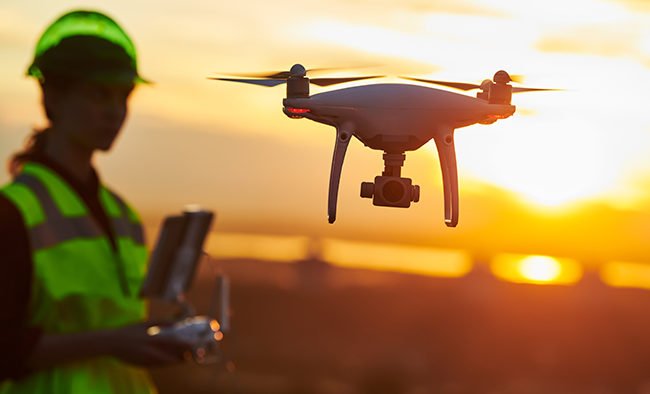

Reflecting on the past decade, it’s remarkable how technology has become more interwoven into our daily lives and work. From the first tablets and smart watches to battery-powered cars and consumer drones, technology has changed the world around us in ways we wouldn’t have imagined back in 2010.
The same could be said about how technology has impacted the construction industry in the 2010s, which has transformed worksites across the country. Aerial imagery and data captured by drones are some of the quickest and safest ways contractors can select new sites, monitor the progress, and measure stockpiles. With the new decade ahead, it’s a great opportunity for the industry to look back on the changes made and look ahead to where we’re going.
How Drones Came to Be Useful
When the Federal Aviation Administration (FAA) first defined airspace in the 1950s, it was done so with airplanes in mind, not impending technology advancements. By the time commercial-grade drones came along, there was a lot of confusion on when and where drones could fly.
In order for drones to be leveraged in the construction industry, the FAA first needed to put clear rules in place to make drones accessible in a commercial setting. The changes that the FAA has made over the past 10 years have been instrumental to the progression of the drone industry as well as other industries that leverage drones.
Two of the most drastic changes of the decade are the Part 107 program and Low Altitude Authorization and Notification Capability (LAANC). Think of the Part 107 program as a driver’s license — it’s a one-time test to provide a license for commercial pilots to fly drones. This program increased the drone pilot pool to over 120,000 in the United States, which, in turn, expanded the number of pilots that contractors had access to and could hire.
In 2017, the FAA began rolling out LAANC across the country. This set of regulations allows commercial drone pilots to check airspace clearance directly with the FAA in real time. LAANC has changed the game since it allows access to roughly 25 to 30 percent of buildings that were previously in restricted airspace, roughly within five miles of a local airport. Previously, drones weren’t authorized to fly in those areas. And if a pilot needed to fly within these boundaries, there was a 90-day wait time to receive clearance from the FAA, at which point would delay projects. Now, drone pilots can easily get clearance in a matter of seconds, so contractors are able to stay on track and rely on drones 99 percent of the time.
Changes Throughout the Decade
Drones have become the go-to tool in the 2010s to gather images and video for safely mapping projects, reporting progress updates and gaining insights through advanced analytics. Before drones, aerial images were only accessible through a helicopter or a person taking a picture from a crane. With the first being expensive and the latter being dangerous, aerial data wasn’t always accessible for every project. By having access to this information, contractors and stakeholders have been able to make better decisions about their projects, which is critical to avoid unnecessary delays.
Throughout the decade, drones have also come a long way and made significant technological advancements, such as safety features, production-quality cameras and flightpath mapping. Obstacle avoidance and extended battery life have helped ensure construction sites are safer when utilizing drones to conduct safety inspections. Builders sometimes put themselves at risk, whereas drones performing the same task are able to acquire imagery without common accidents like slips, trips or falls from heights. With high-resolution imagery and careful flightpath mapping, contractors have been able to rely on drones to gather photographs and data.
Where We’re Going
Since 2010, it’s clear that technology has enhanced the world around us. Looking ahead to the 2020s, I anticipate that technology will continue to augment the construction industry. In the more immediate future, I believe drones with thermal sensors and ground control points (GCPs) will continue to gain more traction and be leveraged on construction sites. Thermal sensors allow contractors to see problems that aren’t noticeable to the naked eye. In conjunction with thermal, contractors can supplement their findings with GCPs to create even more accurate maps of a worksite than a drone by itself.
Just as technological enhancements have made computers more affordable, advanced sensors, such as thermal, infrared and LiDAR, will become more affordable. For example, LiDAR, or Light Detection and Ranging, will allow contractors to more accurately survey a site within minutes and spot potential problems well in advance. Although we’re still a long way away from leveraging LiDAR cost effectively, I believe that thermal drone technology will be helpful for contractors in the early 2020s.
Until recently, thermal technology hasn’t been as accessible due to the high price point. Now, not only are more drones equipped with these advanced sensors but also there are more opportunities for drone pilots to learn how to use these drones and decipher the raw data. These powerful drones are able to gather more advanced data and imagery that isn’t noticeable to the naked eye, enabling contractors and surveyors to identify minor problems more quickly, whether a water leak or crack, before they become a serious issue.
As we leave behind the 2010s, I’m looking forward to seeing how continued progress for regulations and more advancements in technology move the drone industry forward and how contractors are able to leverage this in order to select sites, safely monitor projects and market new buildings throughout the 2020s.
Dan Burton is the founder and CEO of DroneBase, the largest global drone operations company, which provides businesses with aerial information to make better, real-time decisions about their most critical assets.
